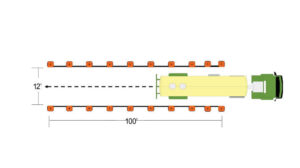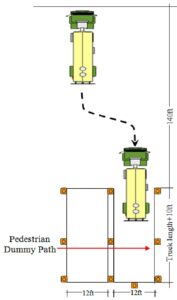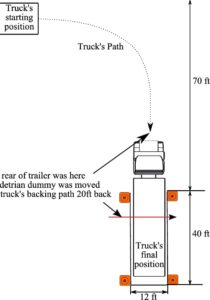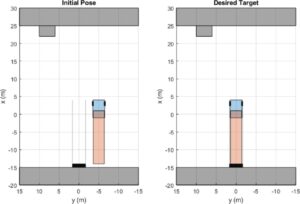Key Takeways
- The CDL Backing Test checks a driver’s ability to reverse a truck with control.
- Drivers must master straight-line backing, offset backing, alley docking, and parallel parking.
- Mistakes like poor mirror use, oversteering, and crossing lines can lead to failure.
- Using GOAL (Get Out And Look) helps check positioning and avoid obstacles.
- The test is scored on control, boundaries, speed, and final positioning.
- Practice with cones and slow movements improves accuracy and increases success.
The CDL Backing Test evaluates a driver’s ability to maneuver a commercial vehicle in reverse with precision and control. It is an essential part of the CDL skills test, assessing spatial awareness, mirror usage, and steering accuracy.
To pass, drivers must execute backing maneuvers within defined boundaries while avoiding excessive corrections, boundary violations, and unsafe practices.
Types of Backing Techniques
The backing maneuvers tested in the CDL exam usually consist of four primary maneuver types: alley dock, parallel park, offset backing, and straight back. Each technique has its own set of rules and can be challenging at times. Drivers must demonstrate that they can back the massive truck even in limited spaces while abiding by the regulations and ensuring safety. The different types of backing maneuvers are explained below.
Straight Line Backing
- The driver must reverse in a straight path between cones without deviation.
- Side mirrors should be used continuously to maintain alignment.
- Small steering corrections help keep the truck centered.

Offset Backing
- The vehicle must be backed into a space that is offset from the starting lane.
- Requires precise steering to avoid crossing boundary lines.
- Mirror usage is critical to judge clearance.

Alley Dock
- The vehicle must reverse at a 90-degree angle into a designated space, simulating a docking bay.
- Requires precise depth perception and trailer control.
- GOAL (Get Out And Look) is recommended to check final positioning.
Each of these maneuvers is scored based on control, mirror usage, and boundary violations.

Parallel Parking
- The truck must be backed into a space parallel to a curb or boundary line.
- Proper alignment before starting is necessary to fit within the space.
- Small, controlled movements help adjust positioning.

CDL Backing Test Requirements

To pass the CDL Backing Test, drivers must adhere to the following guidelines:
- Stay within designated boundaries – Crossing lines or hitting cones results in deductions.
- Use mirrors frequently – Constant mirror checks ensure alignment and obstacle awareness.
- Maintain slow, controlled movements – Speeding reduces accuracy and increases mistakes.
- Avoid excessive corrections – Too many steering adjustments can lead to misalignment.
- Use GOAL (Get Out And Look) – Exiting the vehicle to check positioning prevents errors.
Failure to meet these requirements can result in a failed test.
7 Mistakes to Avoid while Backing
Not Using Mirrors Properly
- Failure to check mirrors often results in misalignment.
- Blind spots must be checked before and during movement.
Oversteering or Understeering
- Making excessive or insufficient steering adjustments can cause the vehicle to veer off course.
- Minor corrections should be made instead of abrupt turns.
Crossing Boundary Lines
- Exceeding test lane limits leads to automatic point deductions.
- Proper vehicle positioning before starting a maneuver helps avoid this mistake.
Ignoring Blind Spots

- Not checking for objects or hazards can result in failed tests and unsafe driving habits.
- Blind spots should be cleared before reversing.
Backing Too Fast
- Speed reduces reaction time, making it harder to correct errors.
- Slow, controlled movements allow for better maneuverability.
Poor Starting Alignment
- Beginning the maneuver from an incorrect position makes it harder to complete the task properly.
- Drivers should set up their entry position carefully before starting.
Failing to Use GOAL
- Staying inside the cab without verifying positioning can lead to errors.
- Stepping out to check space, alignment, and clearance is highly recommended.
Avoiding these mistakes helps drivers maintain accuracy and pass the test.
Exiting the Vehicle for Outside Observation (GOAL)
GOAL (Get Out And Look) is an important safety practice that allows drivers to assess their vehicle’s positioning before proceeding with a backing maneuver.

Why is GOAL Important?
- Prevents misalignment – Allows drivers to check if they are within test boundaries.
- Identifies obstacles – Helps avoid collisions with cones or barriers.
- Reduces excessive corrections – Checking alignment before moving forward minimizes unnecessary repositioning.
CDL examiners encourage GOAL as a best practice, and using it strategically can improve test results.
Scoring Parameters in CDL Tests
CDL backing tests are graded based on specific criteria. Drivers must meet these scoring requirements to pass.
Vehicle Control
- Smooth and precise movements are expected.
- Oversteering, abrupt corrections, or uncontrolled movements lead to deductions.
Boundary Violations
- Crossing lines or hitting cones results in penalties.
- Staying within the marked area is necessary for a passing score.
Mirror Usage
- Frequent mirror checks are required for safety.
- Failing to monitor surroundings results in deductions.
Speed Control
- Drivers must maintain slow, steady movement.
- Backing too quickly reduces accuracy and control.
Final Positioning
- The vehicle must end within the designated space without excessive repositioning.
- If alignment is off, drivers may be asked to redo the maneuver.
Exceeding the maximum number of errors results in test failure.
Hand and Steering Techniques for Effective Backing
Proper hand placement and steering control improve precision during backing maneuvers.
- Hand-Over-Hand Steering – Best for tight turns and minor adjustments.
- Push-Pull Steering – Helps maintain smooth, controlled movements.
- 6 o’clock Hand Position – Holding the wheel at the bottom allows precise trailer control.
By using these techniques, drivers can make controlled corrections without oversteering.
How to Practice for the CDL Backing Test

What Happens If You Fail the CDL Backing Test?
- Most states allow retakes – The number of attempts permitted varies by state.
- Review mistakes – Identifying problem areas and practicing them improves performance.
- Seek additional training – CDL instructors can help correct errors and improve techniques.
Drivers should analyze their errors and refine their skills before retesting.
FAQs: CDL Backing Test
How many points can you lose on the CDL backing test?
Each state has different scoring rules, but excessive penalties (hitting cones, crossing lines, improper mirror use) can result in failure.
Can I use a spotter during the test?
Most states do not allow spotters. Drivers must rely on mirrors and GOAL for accuracy.
What happens if I hit a cone?
Hitting cones results in penalties. Repeated violations can lead to test failure.
How long does the CDL backing test take?
The test usually takes 10-15 minutes, depending on the number of required maneuvers.
What is the best way to practice?
Using an open lot, setting up cones, and focusing on mirror usage, alignment, and controlled steering movements will improve test performance.
James Johnson is a former truck driver who now works as a writer, specializing in the trucking industry. With over 15 years of experience on the road, James has a unique perspective on the challenges and opportunities faced by truck drivers and the trucking industry as a whole. His writing focuses on issues such as safety, regulation, and the latest industry trends. His work has been featured in several trucking publications and he has received recognition for his contributions to the industry. In his free time, James still enjoys being around trucks and often attends truck shows and other industry events.


